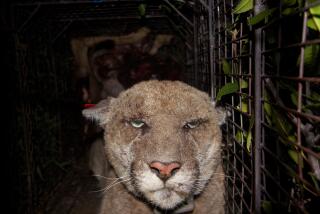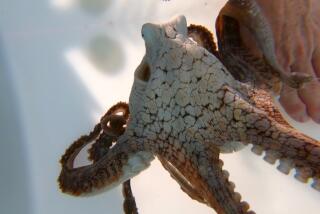Trapping Laws Bite Timber Industry
OLYMPIA, Wash. — Dam-building beavers flood timber land. Coyotes snatch more lambs. River otters treat salmon hatcheries as all-you-can-eat buffets. Nearly a year after Washington voters banned most forms of trapping, trappers, landowners and wildlife officials say they’re dealing with the consequences.
Initiative 713 bans the use of body-gripping traps to capture any mammal for recreation or commerce in fur. It also outlawed two poisons. Initiative sponsors, primarily the Humane Society of the United States, argued that such methods are cruel and inhumane. Nearly 55% of voters--1.3-million people--agreed.
Sales of trapping licenses declined by 36% from 1999 to 2000, according to the Washington Department of Fish and Wildlife. The reported catch of beaver decreased from more than 4,000 per year in 1998 and 1999 to fewer than 1,000 in 2000, when most of the trapping season occurred after the initiative passed. Trappers also took much smaller numbers of coyotes, nutria and river otters.
Now those beavers are chopping down trees and building dams. For landowners, especially owners of timber, that means more young trees in reforested areas dying in beavers’ jaws and more mature timber drowning in beaver ponds.
“As you fly over the countryside you see a lot more ponds where ponds didn’t used to be,” said Bill Pickell, a tree farmer who heads the Washington Contract Loggers Assn. “I enjoy seeing beavers, but the little pesky [critters] always want to expand their universe.”
Before the initiative, the timber industry enjoyed a symbiotic relationship with fur trappers, who controlled the beavers at little or no charge, making their money from pelts.
After the initiative, the cost of beaver removal skyrocketed to more than $100 an animal, with trappers unable to sell fur and forced to use cumbersome cage traps or seek special permits to use traditional body-gripping traps.
The change doesn’t haunt initiative sponsors.
“People are now supposed to be focusing on non-lethal ways to deal with their wildlife problems,” said Lisa Wathne of the Humane Society. “If the department is adequately enforcing that, we can expect to see a big drop in the number of animals trapped in Washington State, and that was certainly the purpose of the initiative.”
The department issued 224 special trapping permits so far this year. More than half were for beaver trapping, and about 400 beaver have been taken, said Lt. Steve Dauma, who oversees I-713 enforcement for the Department of Fish and Wildlife.
Body-gripping traps were also standard for the wildlife managers who tend the public’s lands and private operators who make their living removing nuisance wildlife, from coyotes to moles.
Those operators are suffering under restrictions the initiative’s supporters downplayed during the campaign, Dauma said.
“It was much broader than just affecting commerce and recreation in fur,” Dauma said.
The initiative’s exemptions for wildlife management and control are restrictive and inconsistent, critics say. The department can grant special permits to use some body-gripping traps in some circumstances. But the standard mole trap, a scissors-like device that kills the animal almost immediately, was banned, although Wathne contends that wasn’t the intent of the sponsors.
The department must find that non-lethal methods aren’t effective before issuing a permit. That’s a time-consuming and difficult process that can leave people waiting while predators feast on their livestock.
Before Initiative 713, sheep rancher Fred Blauert used foot-hold traps to catch the coyotes who burrowed under the fence that protects his 300-ewe flock near Washtucna. Since the measure’s passage, Blauert said his losses to predators have jumped from 5% to 15%, a tough hit in an industry already hurt by cheap imports of wool and meat from Australia.
Again, the initiative’s sponsors aren’t sympathetic. They advocate non-lethal methods such as guard animals and keeping ewes while they lamb to protect newborns from predators.
“At some point, people need to step back and say: ‘What we’re doing is not only inhumane, it doesn’t work,’ ” Wathne said.
But that’s not necessarily how ranchers react. Among the unforeseen consequences of the initiative is an increased demand for the help of an obscure federal agency known as Wildlife Services, which specializes in protecting livestock, crops, people and property from wildlife.
Blauert and his neighbors recently called in the agency’s aerial gunners to thin out the coyotes attacking their stock, effectively using wholesale coyote killing to replace their piecemeal efforts.
Bill Clay, the agency’s deputy administrator, concedes such methods are controversial, but notes that by outlawing foothold traps and a poison used against coyotes, the initiative cut down on his options.
Another unheralded consequence, Dauma says, is a quirk in the initiative that effectively bans state officials from using foot-hold traps against river otters who feast on salmon smolts at the state’s hatcheries.
Otters typically won’t approach a cage trap. But because the infant salmon aren’t livestock, domestic animals or private property, and the hatchery isn’t private land, the otters don’t fall under exemptions from the body-gripping trap ban.
“Our hatcheries are struggling with trying to address the otter problems without being able to trap them,” Dauma said.
In the densely populated areas around Seattle, John Consolini of Northwest Nuisance Wildlife Control deals daily with conflicts between people and wildlife.
Consolini also says he’s hamstrung by the initiative’s rules as he tries to get otters out of koi ponds, raccoons out of the rhododendrons and moles out of lawns.
He’s using cage traps instead of the foothold traps banned by the initiative. But he says they’re less effective, and his customers are getting less wildlife control for more money, Consolini says.
“We’re getting more and more damage to the person’s property because of this,” Consolini said. ‘
Consolini and his colleagues say the initiative has driven the banned traps underground into the hands of frustrated landowners.
“It stopped a handful of professional trappers, but it put trapping in the hands of a homeowner who knows nothing,” said Matt Houston, who operates Skunkworks in Spokane. “That is going to cause more animal damage.”
More to Read
Sign up for Essential California
The most important California stories and recommendations in your inbox every morning.
You may occasionally receive promotional content from the Los Angeles Times.










